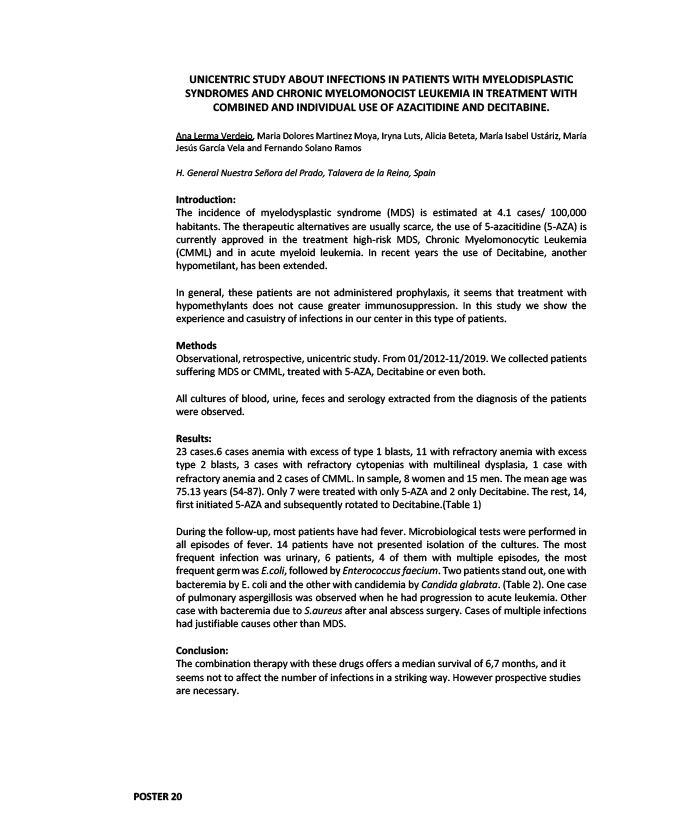
UNICENTRIC STUDY ABOUT INFECTIONS IN PATIENTS WITH MYELODISPLASTIC
SYNDROMES AND CHRONIC MYELOMONOCIST LEUKEMIA IN TREATMENT WITH
COMBINED AND INDIVIDUAL USE OF AZACITIDINE AND DECITABINE.
Ana Lerma Verdejo, Maria Dolores Martinez Moya, Iryna Luts, Alicia Beteta, María Isabel Ustáriz, María
Jesús García Vela and Fernando Solano Ramos
H. General Nuestra Señora del Prado, Talavera de la Reina, Spain
I
ntroduction:
The incidence of myelodysplastic syndrome (MDS) is estimated at 4.1 cases/ 100,000
habitants. The therapeutic alternatives are usually scarce, the use of 5-azacitidine (5-AZA) is
currently approved in the treatment high-risk MDS, Chronic Myelomonocytic Leukemia
(CMML) and in acute myeloid leukemia. In recent years the use of Decitabine, another
hypometilant, has been extended.
In general, these patients are not administered prophylaxis, it seems that treatment with
hypomethylants does not cause greater immunosuppression. In this study we show the
experience and casuistry of infections in our center in this type of patients.
Methods
Observational, retrospective, unicentric study. From 01/2012-11/2019. We collected patients
suffering MDS or CMML, treated with 5-AZA, Decitabine or even both.
All cultures of blood, urine, feces and serology extracted from the diagnosis of the patients
were observed.
Results:
23 cases.6 cases anemia with excess of type 1 blasts, 11 with refractory anemia with excess
type 2 blasts, 3 cases with refractory cytopenias with multilineal dysplasia, 1 case with
refractory anemia and 2 cases of CMML. In sample, 8 women and 15 men. The mean age was
75.13 years (54-87). Only 7 were treated with only 5-AZA and 2 only Decitabine. The rest, 14,
first initiated 5-AZA and subsequently rotated to Decitabine.(Table 1)
During the follow-up, most patients have had fever. Microbiological tests were performed in
all episodes of fever. 14 patients have not presented isolation of the cultures. The most
frequent infection was urinary, 6 patients, 4 of them with multiple episodes, the most
frequent germ was E.coli, followed by Enterococcus faecium. Two patients stand out, one with
bacteremia by E. coli and the other with candidemia by Candida glabrata. (Table 2). One case
of pulmonary aspergillosis was observed when he had progression to acute leukemia. Other
case with bacteremia due to S.aureus after anal abscess surgery. Cases of multiple infections
had justifiable causes other than MDS.
Conclusion:
The combination therapy with these drugs offers a median survival of 6,7 months, and it
seems not to affect the number of infections in a striking way. However prospective studies
are necessary.
POSTER 20